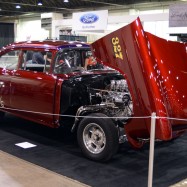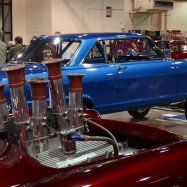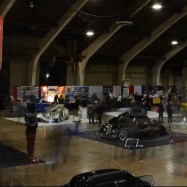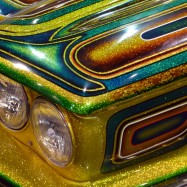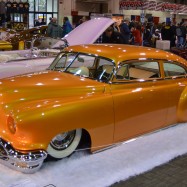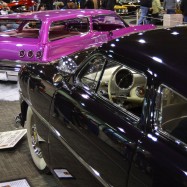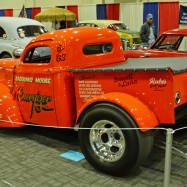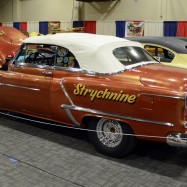It’s the Granddaddy of ‘Em All (And Hot Rodding Wins!)

Last weekend, a decision was made where hot rodding won. It was an informed decision—one that was measured, calculated, analyzed and scrutinized inside a collective prefrontal cortex and mulled over for days on end. The panel responsible for this decision had studied the texts typeset by their predecessors—little pages and big pages—that brought the wild and wonderful world of indoor car shows into the homes of those who could only fantasize about diving into the sea of angel hair and pearl paint. The judges knew what it took to win in the past and what’s required for the present. At the end of the weekend, somebody would be taking home the big trophy at the Grand National Roadster Show—The Granddaddy of ’em all.
In the center of a long, narrow building marked “Exhibits,�? a golden cup with a stepped base towered above the show floor. Its body was riddled with plaques engraved with the names of our hobby’s innovators—craftsmen who pushed themselves to the edge of their physical, mental and financial means to create cars that tapped into the consciousness of the general public. It’s an experiment. It’s an art. It’s a risk.
All the talk of psychology and in-depth analytics seem to be forgotten when the gates open and the people power-walk through the doors to figure out what’s happening. They’ve already marked the day off work (called in sick) and they’ve already paid for parking. Batteries have been charged, passes have been bought and show programs are rolled beneath arms. The people came to see the cars—lines and lines of machines customized for hundreds of reasons in thousands of ways—that fill a handful of WPA-era buildings on the Pomona Fariplex.
Within the main building—best known as Building Four—these cars are parked on squares of carpet, tile and sometimes wood. They’re classified as the Roadsters, and they’re positioned in these 20×20-foot pens marked with metal and rope so overzealous spectators don’t come by to run their fingers along their glass-like finishes. It’s a good thing these barriers are in place, because each car is formed from top-shelf china and bathed in colors that span the Pantone spectrum. On some, every piece of metal looks as if it’s made of mirrors, and mirrors are placed underneath for those wishing to investigate further. (This abundance of reflective finishes has become commonplace for those running for the title of America’s Most Beautiful Roadster.)
Regardless of how many mirrors a car has in its display, it has to be powered by an engine. This year, every entry had at least one. Most were of the V8 variety. Some engines were out in the open with carburetors and scoops and pipes assembled in military-grade formation, while others kept to themselves under hand-formed covers and custom made hoods. Three-twos, six-twos, two-fours—you name it—inductions came in all configurations on the show floor.
It wasn’t all about counting carburetors at the Roadster Show. Voices of the masses burbled inside Building Four, bouncing off its ribbed ceiling and blending with the seemingly ever-present Zombies track Time of the Season. “Do you want that one, or that one?�? a father asked his young sons, pointing at two of the cars in competition for the big trophy. They hesitated—couldn’t make up their minds. Don’t worry, I thought, neither can I.
To my left, a man in a cowboy hat looked through the cracked screen of his iPad to take a picture of a coachbuilt roadster from California. He didn’t take a complimentary poster. Across the aisle, someone mentioned something about Boyd Coddington, while another reminisced about a GNRS entry from a previous year (or maybe lifetime?) that cost the owner $200,000. There was talk of cars that were built from sheets of metal and those that were welded together up north near the River Rouge. Roadsters inspired by land speed racers and factory workers shared the floor with cars with ties to television stars and musicians. It made for a vibrant display that resulted in widened eyes and quickened pulses.
This air of quality wasn’t unique to the world of Building Four. Every building on the complex was filled with the cars you’ve only seen in awkwardly cropped Instagram photos that you’ve given a seal of approval with a double tap of your thumb. They’re the cars you’ve seen in magazines, the cars you’ve seen on the H.A.M.B. and the cars you want to learn something from.
An old Lloyd with a six-carbed Olds stuffed beneath the cowl. A new ’55 Chevy C/Gasser with a roof covered with a maze of candies, panels, fades and lines. Rod & Custom’s first cover car. A survivor ’59 Impala mild custom with a red and white interior (that’s oh-so-right…) The list doesn’t stop. The number of high quality rods, customs and racecars in attendance was so incredibly high that it was an unattainable goal to see them all. But of all the entrants (the promoters claim the count is up near 1,000) an earth-toned roadster caught the eye of just about everyone.
That particular 1932 Ford belongs to Darryl and Terri Hollenbeck, the winners of the 2016 America’s Most Beautiful Roadster award. There’s been a well-deserved media frenzy surrounding the roadster since its been built, and even more so now that it has netted the AMBR title. Last fall, I spent a fair amount of time getting to know Darryl while writing the feature on the car for The Rodder’s Journal #69. He and his close friends built the Rotten Avocado Green ’32 around a traditional hot rod aesthetic with extra emphasis on functionality and detail. More than anything, it was built to drive.
Prior to the awards ceremony on Sunday, I heard somebody ask him if he was nervous about the roadster taking home the top prize. He shook his head and deadpanned, “Not at all.�?
—Joey Ukrop
Note: The following photos are from my trip to the 2016 Grand National Roadster Show while on assignment with The Rodder’s Journal.





